Artificial grass is a fantastic, low-maintenance alternative to natural lawns, offering year-round greenery without the constant need for mowing and watering. However, to keep your synthetic turf looking its best, regular maintenance and care are essential. There we delve into various aspects of artificial grass upkeep, from weekly routines to deep cleaning methods and advanced care tips.
Key to Maintaining Artificial Grass Maintenance
The key to maintaining the aesthetic appeal of clean artificial grass lies in understanding its unique maintenance requirements. Unlike natural grass, synthetic turf doesn’t grow or change organically, meaning that it requires specific cleaning and care techniques to remain vibrant and lifelike. Regular maintenance is crucial to prevent the accumulation of debris and to maintain the structural integrity of the artificial blades.
Weekly Maintenance Routines
To ensure your artificial grass remains in top condition, weekly maintenance routines are a must. These simple yet effective practices help maintain the appearance and functionality of your synthetic turf.
Debris and Leaf Removal Techniques
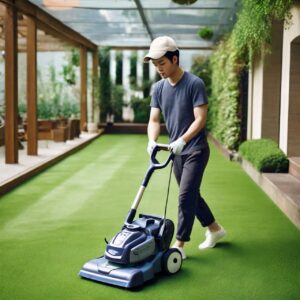
Leaves, twigs, and other debris can accumulate on artificial grass, leading to a messy appearance and potential drainage issues. Maintaining the cleanliness of artificial turf is essential for its longevity and aesthetic appeal. Here we explore the best tools and techniques for efficient debris removal.
Using a Leaf Blower: A leaf blower is an efficient tool for removing loose debris. When using a leaf blower, it’s important to set it on a low power setting to prevent damage to the turf fibers. Start from one corner and systematically move across the lawn, ensuring all areas are covered. This method is particularly effective for larger areas and can significantly reduce the time spent on cleaning.
Employing a Gentle Rake: For smaller lawns or more precise debris removal, a gentle rake specifically designed for artificial grass is ideal. These rakes have softer, non-metal tines that won’t damage the turf. Gently rake over the surface to collect leaves and twigs. This method is also useful for fluffing up the turf fibers if they’ve become flattened.
Alternative Tools and Techniques:
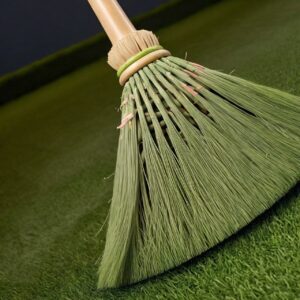
Garden Vacuum: Similar to a leaf blower, a garden vacuum can suck up debris from the turf. Some models come with a shredder function to minimize the volume of the waste collected.
Power Broom: For more thorough cleaning, a power broom can be used. This tool is especially useful for removing debris that has become embedded in the turf fibers.
Manual Methods: For small patches of turf or for those preferring not to use power tools, manually picking up larger debris and then using a soft-bristled brush can be effective.
Routine Maintenance Tips: Regularly removing debris, ideally once a week, will prevent accumulation and make the task easier. It’s also important to inspect the turf for any signs of wear or damage during cleaning.
Preventive Measures: Consider using plant covers or netting during autumn to minimize leaf fall on the turf. Positioning waste bins and compost areas away from the artificial grass can also reduce the likelihood of debris.
By employing these techniques, you can ensure that your artificial grass remains clean, functional, and visually appealing. Regular maintenance not only enhances the appearance of your lawn but also extends its lifespan, making it a worthwhile investment in the beauty of your outdoor space.
Grass Blade Brushing for a Natural Look
Over time, the blades of artificial grass can become flat and lose their natural appearance. Regular brushing against the grain with a stiff broom can help rejuvenate the blades, ensuring your turf looks fresh and realistic.
Essential Rinsing Practices
Dust and small particles can settle on artificial turf, dulling its appearance. A routine rinse with a garden hose is a simple yet effective way to keep your grass looking clean and vibrant.
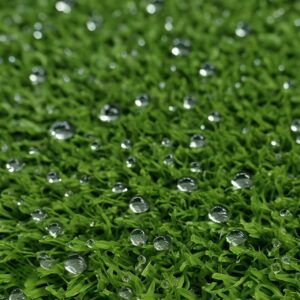
Monthly Deep Cleaning Steps
While weekly maintenance tackles surface-level concerns, monthly deep cleaning is vital for addressing more ingrained dirt and stains.
Effective Stain Treatment Methods
Spills and pet messes on artificial grass are inevitable, but with prompt and appropriate treatment, you can prevent permanent staining and maintain the appearance of your lawn. Here’s a guide on how to tackle these common issues using mild, turf-safe cleaning agents for effective spot cleaning.
Immediate Action: The key to effective stain removal is prompt action. As soon as a spill or pet mess occurs, remove any solid waste and blot up liquids with paper towels or a clean cloth, avoiding rubbing the area to prevent the stain from setting in.
Choosing the Right Cleaning Agents:
Mild Detergent Solution: Mix a mild, non-abrasive detergent with water. This solution is effective for most common stains such as drinks, food spills, and pet urine. Apply the solution to the stained area, gently brush it with a soft-bristled brush, and then rinse thoroughly with water.
Vinegar and Water Solution: For tougher stains or to neutralize pet odors, a mixture of equal parts vinegar and water can be used. Vinegar is a natural, eco-friendly cleaner that is safe for artificial turf. Apply it to the area, let it sit for a few minutes, and then rinse.
Enzymatic Cleaners for Pet Messes: For pet feces or urine, enzymatic cleaners specifically designed for artificial grass can be highly effective. These cleaners break down the proteins in pet waste, eliminating odors and stains.
Techniques for Spot Cleaning:
- Gentle Brushing: After applying the cleaning solution, gently brush the area with a soft-bristled brush. This helps the solution penetrate the turf fibers and lift the stain.
- Rinsing: Rinse the area thoroughly with water after cleaning. This step is crucial to remove any residual cleaning agent, which could attract more dirt if left on the turf.
Preventative Measures:
- Regular Maintenance: Regularly rinse your artificial grass to prevent buildup of dust and dirt, which can make it more susceptible to staining.
- Pet Training: If pets are the main cause of stains, consider designating specific areas for them and train them to use these areas.
Odor Neutralization with Natural Solutions
Pet owners often struggle with lingering odors on artificial grass. A diluted vinegar solution can be a safe and effective way to neutralize these smells without damaging the turf.
Targeted Cleaning for Stubborn Grime
For more stubborn dirt and grime, a soft brush and a specially formulated turf cleaner might be necessary. This part will discuss how to use these products effectively while avoiding harsh chemicals that could damage the grass.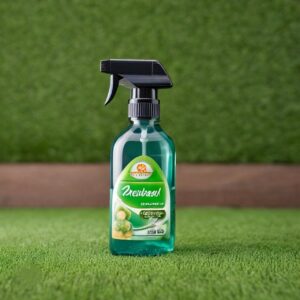
Importance of Thorough Rinsing
Rinsing your artificial grass thoroughly after any cleaning process is a critical step that should not be overlooked. This practice plays a significant role in maintaining the health and appearance of your turf. Here’s why this step is so important and how to effectively rinse your artificial grass.
Residue Removal: Cleaning agents, whether they are mild detergents, vinegar solutions, or specialized turf cleaners, leave residues if not rinsed off properly. These residues can attract more dirt and dust, leading to a dirtier lawn over time. They can also cause the turf fibers to stick together, diminishing the natural look of your grass.
Preventing Damage: Certain cleaning products, especially those not specifically designed for artificial turf, can cause damage if their residues are left on the turf. This includes discoloration, deterioration of the turf fibers, and breakdown of the backing material.
Ensuring Safety: For households with children and pets, it’s essential to ensure that no harmful cleaning product residues remain on the turf. Thorough rinsing eliminates this concern, making the lawn safe for everyone to enjoy.
How to Rinse Effectively:
Use Plenty of Water: It’s important to use enough water to thoroughly flush out all cleaning agents. This might mean going over the area several times.
Even Coverage: Make sure to rinse the entire area where the cleaning solution was applied. Missed spots can lead to uneven cleaning and potential residue buildup.
Check Drainage: Ensure that your turf’s drainage system is working correctly. Effective drainage is crucial for removing both the cleaning agents and the water used for rinsing.
Regular Rinsing: Even if you haven’t applied a cleaning solution, regular rinsing of your artificial grass helps to keep it clean and free of dust and pollen, contributing to its overall maintenance.
Advanced Care Tips
Advanced care tips provide additional strategies to keep your artificial turf in prime condition, addressing issues like weed control, infill management, and temperature considerations.
Weed Control Strategies
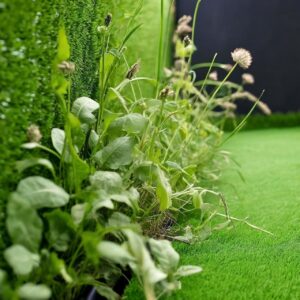
While artificial turf offers a low-maintenance alternative to natural grass, pesky weeds can still sprout and disrupt its pristine look. But fear not! By proactively taking preventative measures, you can minimize this issue and enjoy a weed-free haven. We will guide you on selecting and applying safe, effective solutions to keep your artificial turf looking its best.
Before We Begin:
- Identify the culprit: Different types of weeds require different approaches. Knowing the specific weeds plaguing your turf will help you choose the most effective treatment.
- Safety first: Always prioritize solutions labelled safe for artificial turf and non-toxic to pets and children.
Preventative Measures:
Pre-emergent herbicides: These are your first line of defense, applied before weeds even emerge. Look for formulas specifically designed for artificial turf, often containing corn gluten meal or similar organic ingredients. Apply according to the product instructions, typically in early spring and fall.
Fabric weed barrier: This goes beneath your artificial turf during installation, creating a physical barrier against weed growth. If your turf wasn’t installed with one, consider edge treatments along borders to prevent weeds from creeping in.
Maintaining proper drainage: Poor drainage creates a breeding ground for weeds. Ensure your turf has adequate drainage to prevent water pooling, which can encourage weed germination.
Addressing Existing Weeds:
Hand-pulling: For small infestations, simply pull the weeds out by hand, ensuring you remove the entire root system. Wear gloves and use a weeding tool for stubborn ones.
Spot treatment with herbicides: Choose a targeted herbicide specifically formulated for artificial turf and safe for surrounding plants. Apply directly to individual weeds, following the product instructions meticulously.
Infill Management and Balancing
Artificial grass infill, those tiny sand-like particles sprinkled between the blades, might seem insignificant, but it’s a vital component for the look, feel, and performance of your synthetic turf. Just like Goldilocks and her porridge, the infill level needs to be “just right” – not too much, not too little. Learn about managing and balancing your infill, ensuring your artificial grass thrives.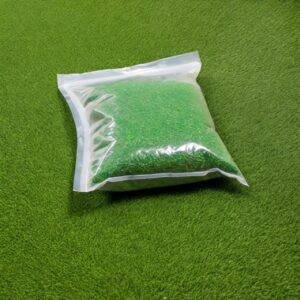
What Does Infill Do?
- Keeps blades upright: Infill helps the blades stand tall, preventing them from matting down and creating a realistic, lush appearance.
- Provides cushioning: Infill adds a layer of cushioning, making the turf more comfortable to walk and play on.
- Maintains drainage: Infill allows water to drain properly through the turf, preventing puddles and potential health hazards.
- Protects the backing: Infill shields the turf’s backing from sun damage and wear-and-tear.
Signs You Need Infill Management:
- Matted blades: If your turf feels lumpy or the blades are leaning over, it’s likely time to add more infill.
- Bare spots: Visible gaps between the blades indicate infill loss, requiring replenishment.
- Splashing after rain: Puddles forming on the surface suggest poor drainage, potentially due to insufficient infill.
- Excessive infill: If you see sand migrating onto walkways or patios, you might have too much infill.
Managing Your Infill:
- Regular inspection: Walk across your turf barefoot to feel for unevenness or matting. Visually inspect for bare spots or excessive infill migration.
- Brushing: Use a stiff bristle broom to brush the turf regularly, redistributing infill and keeping blades upright.
- Leveling: Use a rake to level out any uneven areas where infill might have accumulated.
- Adding infill: If needed, add infill gradually, following the manufacturer’s recommendations and using the appropriate type of infill for your turf.
Balancing Act: Choosing the Right Infill
Different infill materials offer varying benefits and suit specific needs. Here are some common options:
- Sand: Affordable and readily available, but can compact over time and potentially migrate.
- Rubber crumb: Provides good drainage and cushioning, but can get hot in direct sunlight.
- Silica sand: Rounded shape prevents compaction and offers good drainage, but can be more expensive.
- Encapsulated sand: Coated sand resists migration and heat build-up, but is the priciest option.
Managing Heat Exposure
Living in a sun-soaked paradise might sound ideal, but for artificial turf, scorching temperatures can pose a challenge. The synthetic fibers can absorb and retain heat, potentially leading to warping, melting, or even burns. But fear not, shade-loving friends! With a few strategic tactics, you can keep your artificial turf cool and prevent heat-related woes.
Scheduling is Key:
Just like planning your day around the hottest hours, schedule deep cleaning and maintenance for your artificial turf during cooler times. Aim for early mornings or late evenings when the sun’s intensity is lower.
Embrace the Shade:
If possible, provide shade for your artificial turf during peak sun hours. This could involve planting trees or installing shade structures like awnings or umbrellas. Even strategically placed patio furniture can offer pockets of respite.
Cool It Down with Water:
Giving your artificial turf a gentle rinse with a hose during hot days can help bring down its temperature. Avoid using high-pressure settings, as these can damage the fibers.
Choose Wisely:
When installing artificial turf in a hot climate, opt for lighter colors that reflect heat instead of absorbing it. Darker shades tend to get much hotter.
Be Infill Savvy:
The type of infill you use can also impact heat absorption. Silica sand or other rounded infill materials tend to stay cooler than traditional sand. Consult your turf supplier for recommendations specific to your climate.
Troubleshooting Common Issues
Even the most well-maintained artificial grass can face some challenges over time. Here we will dicuss tackling common issues like matting, fading, pet damage, and more, ensuring your artificial turf stays beautiful and functional for years to come.
Dealing with Matting and Fading
Prevention:
- Regular brushing: Use a stiff bristle broom to brush your turf against the grain once a week. This helps redistribute infill and prevent blades from matting down.
- Limit high-traffic areas: Define designated walkways to distribute foot traffic and avoid concentrated wear and tear on specific areas.
- Choose fade-resistant materials: Opt for high-quality turf with UV stabilizers to minimize sun damage and fading.
Solutions:
- Power brushing: For stubborn matting, rent a power brush specifically designed for artificial turf. Follow the manufacturer’s instructions and avoid overly aggressive brushing.
- Infill management: Ensure proper infill levels to support blade structure and prevent matting. Add or redistribute infill as needed.
- Professional cleaning: In extreme cases, consider hiring a professional cleaning service experienced in artificial turf maintenance.
Pet Damage:
Prevention:
- Train your pets: Train your pets to use designated potty areas away from the artificial turf.
- Enzyme cleaners: Regularly use enzymatic cleaners to break down pet waste odors and prevent stains.
- Infill selection: Choose an infill material that is pet-friendly and resistant to odors. Silica sand is a good option.
Solutions:
- Remove waste promptly: Pick up pet waste immediately to prevent staining and odor buildup.
- Clean messes thoroughly: Use enzymatic cleaners or a mild soap solution to clean any remaining residue. Rinse thoroughly with water.
- Patch repairs: For minor tears or digs, purchase artificial turf repair kits and follow the instructions for patching the damaged area.
- Professional repair: For extensive damage, consult a professional installer for repairs or turf replacement.
Seasonal Care Guidelines
Just like your wardrobe changes with the seasons, so should your artificial turf maintenance routine. Here’s tailored advice for each season, ensuring your artificial grass thrives throughout the year.
Winter Maintenance and Snow Removal
Snow Removal:
- Shovel with care: Avoid metal shovels, as they can damage the fibers. Opt for plastic shovels or push brooms.
- Blower power: For light snow, use a leaf blower or snow blower with rubber edges. Avoid high settings and direct contact with the turf.
- Let it melt naturally: When possible, let the snow melt on its own to minimize potential damage.
Winter Maintenance Tips:
- Debris removal: Clear leaves, branches, and other debris regularly to prevent moisture buildup and potential mold growth.
- Drainage check: Ensure proper drainage to avoid water pooling and freezing, which can damage the turf and underlying base.
- Pet waste management: Remove pet waste promptly to prevent stains and odors, especially during freezing temperatures.
Summer Care and Heat Management
Heat Management:
- Shade strategies: Install shade structures like umbrellas or awnings, or plant trees to provide shade during peak sun hours.
- Early morning watering: Give your turf a gentle rinse early in the morning to cool it down before the heat intensifies.
- Lighter infill: Consider using lighter-colored infill materials that reflect heat instead of absorbing it.
Summer Care Tips:
- Brushing frequency: Increase brushing frequency to prevent matting and distribute infill evenly.
- Weed control: Stay vigilant for weeds and address them promptly using safe, pet-friendly weed control methods.
- Odor control: If you have pets, use enzymatic cleaners regularly to control odors, especially during hot weather.
Pre-Purchase Advice
For those considering installing artificial grass, here is essential pre-purchase advice, covering factors like material quality, pile height, and infill options.
Artificial grass can be a fantastic addition to your home, offering a low-maintenance and vibrant alternative to traditional lawns. But with so many options available, making the right choice can feel overwhelming. Here are essential pre-purchase considerations, ensuring you select artificial grass that perfectly suits your needs and lasts for years to come.
Choosing the Right Fit:
Material Quality: It all starts with the foundation. Opt for high-quality artificial grass made from durable materials like nylon or polyethylene. Avoid low-cost options that might fade quickly or wear down easily. Look for manufacturers who specify the denier weight (thickness) of the fibers, as higher denier indicates greater strength.
Pile Height: This refers to the length of the blades, impacting both aesthetics and functionality. Shorter pile heights (1/2 inch – 1 inch) offer a low-maintenance, realistic look suitable for moderate foot traffic. Taller piles (1.5 inches – 2 inches) feel plusher and provide better cushioning, but require more brushing and might not be ideal for high-traffic areas.
Infill Options: Infill, those tiny sand-like particles between the blades, plays a crucial role in drainage, stability, and even heat absorption. Popular options include silica sand, rubber crumb, and encapsulated sand. Consider factors like climate, usage, and budget when selecting your infill material.
Remember: Don’t solely rely on price as a deciding factor. Investing in quality turf from the outset will save you money and frustration in the long run.
Understanding Your Needs:
Usage: How will you be using your artificial grass? Light foot traffic for a decorative space calls for different considerations than a high-traffic play area for children or pets. Choose turf with appropriate durability and pile height for its intended use.
Climate: Consider your local climate. Opt for UV-resistant fibers if you live in a sunny region, and choose heat-resistant infill options if extreme temperatures are a concern.
Aesthetics: Do you prefer a realistic, lush look, or a clean, modern aesthetic? Artificial grass comes in various colors, textures, and blade shapes. Choose one that complements your overall landscaping style and desired ambiance.
